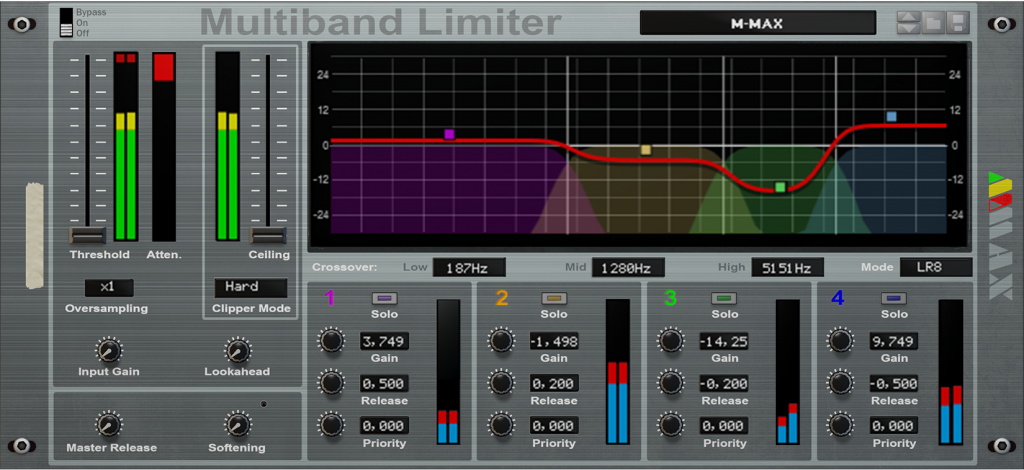
Intro Price until October 15 Do not miss the moment 🙂
Making music louder is simply not enough for modern styles. M-MAX Multiband Limiter not only provides incredible levels of loudness, but also balances the spectrum and adds character, and all this contributes to the overall level of sound quality.
Global Limiter Section:
Threshold – sets the global limiting threshold as a reference threshold for the 4 bands. Once set, any signal that goes above the threshold is limited, and gain is automatically made up by the same factor; i.e., if Threshold is set to -3dB, then automatic makeup gain will accordingly be 3dB. Next to The Threshold fader is located on the Input Meter, allowing easy adjustment with reference to input signal. If you do not have enough input volume, use the Input Gain control before working with the limiter. To the right of the Input Meter is a The Attenuation Meter is displays the overall (wideband) attenuation.
The Lookahead – chooser affects how quickly Limiter will respond to peaks that require compression. Shorter Lookahead times allow for more compression, but with an increase in distortion — particularly in the bass.
Oversampling – running the internal limiting process at a sample rate that is two, three or four times higher than the host’s sample rate.
Master Release – The Release knob adjusts how long it takes for Limiter to return to normal operation after the signal falls below the ceiling. With Softening enabled, Limiter analyzes the incoming signal and sets an appropriate release time automatically.
Softening – depends on your release settings and slightly increases the desired time value depending on the average gain reduction.
Clipper Mode – allows you to choose between from the most transparent but Hard clip, medium, and to the softest but saturated.
Ceiling – fader sets maximum output level, scaling the output signal to reach the out ceiling value but not exceed it. If your incoming signal level has no peaks that are higher than the ceiling, Limiter will have no effect. Next to The Ceiling fader is located on the Output Meter.
Crossover Section:
Filter Mode – LR4 Fourth order Linkwitz–Riley crossover, are probably today’s most commonly used type of audio crossover. They are constructed by cascading two 2nd-order Butterworth filters. Their steepness is 24 dB/octave (80 dB/decade). The phase difference amounts to 360°, i.e. the two drives appear in phase, albeit with a full period time delay for the low-pass section.
LR8 Eighth order Linkwitz–Riley crossover have a very steep, 48 dB/octave (160 dB/decade) slope.
Along the lower edge of the graphic display are 3 crossover displays (Low, mid, High). These can be dragged to adjust the crossovers
Band Controls:
Gain – controls the total gain of each frequency band.
Priority – adjusts the relative limiting across the bands. Raising Priority applies less attenuation to the respective bands (in relation to other bands) while maintaining the same overall limiting; lowering Priority results in more attenuation applied to the respective bands. It’s important to remember that Priority settings are RELATIVE between bands. This means that if all bands are set to the same non-zero priority, it has the same effect as setting all priorities to 0.
Release (per Bands) – The per band Release sets the reference Release time for each band.
THE GRAPHIC DISPLAY has the ability to control:
Gain of each frequency band (Click with the left mouse button and move to the up and down)
Crossover (Sift + Click with the left mouse button and move to the right and to the left)
Back Panel:
On the Back Panel are Stereo Inputs / Outputs, SideChain Inputs and Attenuation CV Outputs for all Bands.
Released: 2017-09-20, Version: 1.0.0, available now in the Prop-Shop
